What are the Multiples of 4? Definition, Examples, and Lists
Multiples play an important role in problem-solving and real-life practical applications. But do you know what multiples of 4 are and why they are so important?
The multiple of 4 is the product of 4 with any natural number. For example, 4 multiplied by 2 is 8, so 8 is a multiple of 4. Some examples of multiples of 4 are 24, 28, 32, 36, and so on. (Note: In the whole number range, every multiple of 8 is also a multiple of 4.)
In this article, we will discuss what are the multiples of 4 and provide a list of multiples of 4. We’ll also cover other values such as the least common multiple of 4 and 6, what is the least common multiple of 4 and 10, and many solved examples with complete explanations.

Whether you are a student, a teacher, or just want to learn basic mathematical knowledge, this article will provide you with clear and practical information.
What are the Multiples of 4?
When we talk about multiples, we mean the result of multiplying a given number by an integer (also known as a whole number). Thus, multiplying a number by 4 gives us a multiple of 4. And the first multiple of each number is the number itself, the multiples of a number are an infinite chain.
For example, if we multiply 6 by 4, we will get 24, which is a multiple of 4. In other words, a number that is divisible by 4 without a remainder is a multiple of 4.
The general form of a multiple of 4 can be written as “4n”, where “n” is a natural number. We can find different multiples of 4 by substituting any natural number for n.
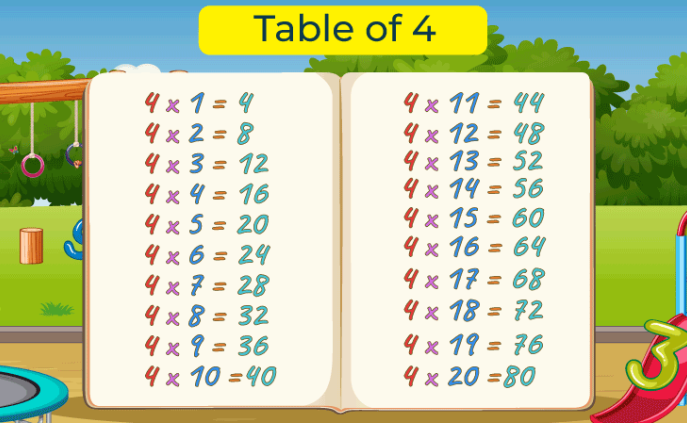
Multiple of 4 = 4 × n, where n is any whole number.
For examples:
- 4 × 0 = 0
- 4 × 1 = 4
- 4 × 2 = 8
- 4 × 3 = 12
- 4 × 4 = 16
These are the first five multiples of 4: 0, 4, 8, 12, and 16.
The value of “n” can be infinite. This means that 4, like any other number, has an infinite number of multiples.
List of Multiples of 4
The below table contains the first 30 multiples of 4 along with the multiplication notation in each case:
| Multiplication of 4 with Natural Numbers | Multiples of 4 |
| 4 × 1 | 4 |
| 4 × 2 | 8 |
| 4 × 3 | 12 |
| 4 × 4 | 16 |
| 4 × 5 | 20 |
| 4 × 6 | 24 |
| 4 × 7 | 28 |
| 4 × 8 | 32 |
| 4 × 9 | 36 |
| 4 × 10 | 40 |
| 4 × 11 | 44 |
| 4 × 12 | 48 |
| 4 × 13 | 52 |
| 4 × 14 | 56 |
| 4 × 15 | 60 |
| 4 × 16 | 64 |
| 4 × 17 | 68 |
| 4 × 18 | 72 |
| 4 × 19 | 76 |
| 4 × 20 | 80 |
| 4 × 21 | 84 |
| 4 × 22 | 88 |
| 4 × 23 | 92 |
| 4 × 24 | 96 |
| 4 × 25 | 100 |
| 4 × 26 | 104 |
| 4 × 27 | 108 |
| 4 × 28 | 112 |
| 4 × 29 | 116 |
| 4 × 30 | 120 |
From the table above, we can see that a multiple of 4 is the result in the multiplication table of 4 because both are the same.
What are the Least Common Multiples of 4?
What does the least common multiple (LCM) of 4 mean? The least common multiple (LCM) of a number is the smallest number that is a multiple of that number and at least one other number. For example, the least common multiple of 4 and 5 is the smallest number of multiples of 4 and 5. In other words, the LCM of 4 and another number is the first number that appears in the multiplication table of both numbers.
For instance:
- The multiples of 4 are: 4, 8, 12, 16, 20, 24, 28, 32, 36, 40…
- The multiples of 5 are: 5, 10, 15, 20, 25, 30, 35, 40…
The smallest number that appears in both sequences is 20, so the least common multiple of 4 and 5 is 20.
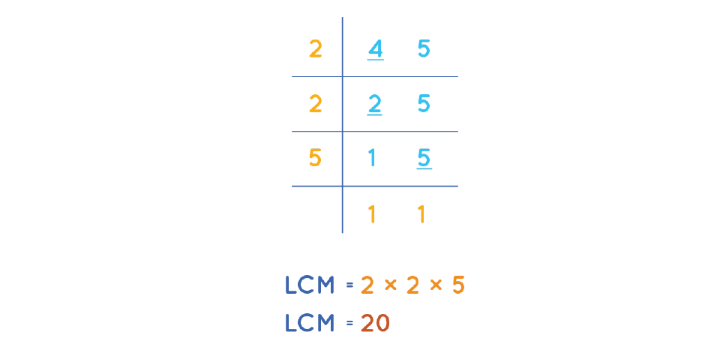
What are the least common multiples of 4 and 6?
The LCM of 4 and 6 is the smallest number that is a multiple of both 4 and 6.
- The multiples of 4 are: 4, 8, 12, 16, 20, …
- The multiples of 6 are: 6, 12, 18, 24, …
- The smallest number that appears in both sequences is 12, so the LCM of 4 and 6 is 12.
This concept is crucial for the addition and subtraction of fractions with different denominators, where the LCM of the denominator needs to be found.
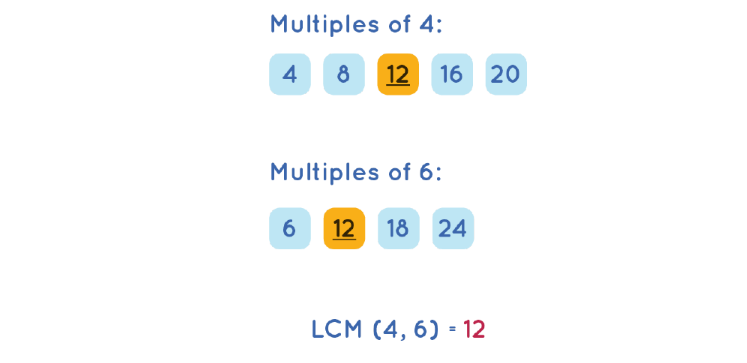
What are Common Multiples in Math?
Common multiples are the multiples that are common between a given set of numbers.
For example, to find the common multiple of 3 and 4, we list their multiples and then find their common multiple.
- The multiples of 3 are: 3, 6, 9, 12, 15, 18, 21, 24, 27, 30, 33, 36, …
- The multiples of 4 are: 4, 8, 12, 16, 20, 24, 28, 32, 36, 40, …
- The common multiples of 3 and 4 are: 12, 24, 36, …
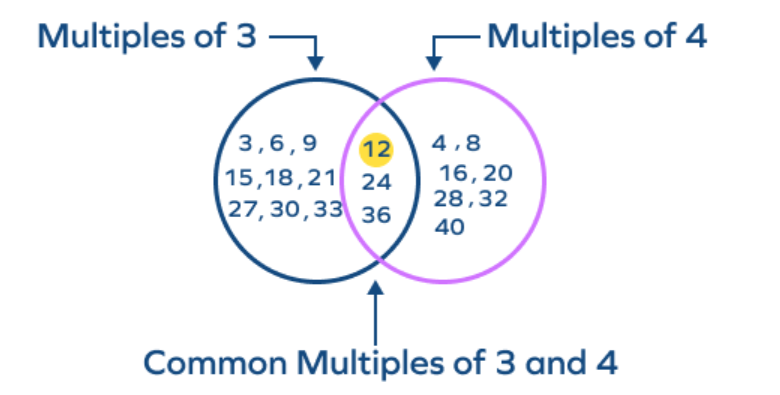
What are the common multiples of 4 and 6?
A multiple is the result of multiplying a number by a whole number. A common multiple of two or more numbers is a number that can be divided by each given number without remainder. A common multiple of two or more numbers is a number that can be divided by each given number without remainder, and this applies to all the numbers in the sequence.
These multiples common to two or more numbers play a vital role in various mathematical operations and problem-solving.
Steps to find common multiples of 4 and 6:
- Step 1: List the multiples of 4 and 6 separately
The multiples of 4 are 4, 8, 12, 16, 20, 24, 28, 32, 36, 40,… and so on.The multiples of 6 are 6, 12, 18, 24, 30, 36, 42, 48, 54, 60,… and so on.
- Step 2: Identify all the multiples that are common in both lists.
- Step 3: Write down all the common multiples in a separate row.
So the common multiples of 4 and 6 are 12, 24, 36, 48, 60, 72, 84, 96, 108, 120,… and so on. Additional common multiples can be identified by continuing this pattern.
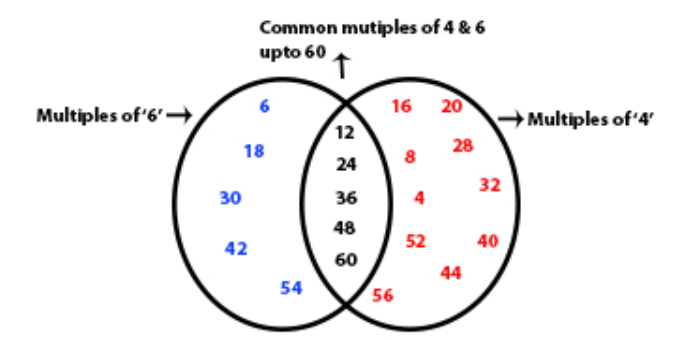
Properties of common multiples
- A number can have an infinite number of multiples. Therefore, any two numbers or group of numbers can have an infinite number of common multiples.
- For any two numbers a and b, the product a x b is always a common multiple of a and b.
Example: 7 x 4 = 28 is a common multiple of 4 and 7.
If two numbers a and b are prime numbers, then their common multiple is a multiple of (a x b).
Solved Multiples of 4 Examples
Here are some examples of solved problems that provide answers to common questions about multiples of 4:
Example 1: What is the least common multiple of 4 and 10?
Answer: Step-by-Step Calculation of the LCM of 4 and 10
- List the multiples of 4:
4, 8, 12, 16, 20, 24, 28, …
- List multiples of 10
10, 20, 30, 40, …
- Find the smallest number that appears in both lists:
The least common multiple is 20.
Therefore, the least common multiple of 4 and 10 is 20.
Example 2: What is the 11th multiple of 4?
Answer: In this problem, we can use the “4n” formula to find the 11th multiple of 4.
Thus, when n = 11, 4n = 4 x n = 4 x 11 = 44
So, the 11th multiple of 4 is 44.
Example 3: Is 73 a multiple of 4?
Answer: 73 is not a multiple of 4. The multiples of 4 closest to 73 are 72 and 76.
How to Represent the Multiples of 4 on a Number Line?
The number line below represents multiples of 4:

Here we can observe a pattern in multiples of 4: when we multiply 4 by n, there is a series of jumps that make 4 add n times.
Frequently Asked Questions
1. Are all multiples of 4 even?
Yes, all multiples of 4 are even because any number multiplied by an even number results in an even number. Since 4 is an even number, its multiples are also even.
2. What are the factors and multiples of 4?
The factors of 4 are 1, 2, and 4. The multiples of 4 include 4, 8, 12, 26, 20, 24, 28, 32, 36, 40, 44, etc.
3. Is 2 a multiple of 4?
No, 2 is not a multiple of 4.
Conclusion:
In this article, we explore what are the multiples of 4 and provide examples, as well as information about common multiples of 4 and more. Hopefully, this article will help you understand multiples better.
Having this information at your fingertips, will not only improve your math skills but also help you to solve more advanced math problems. If you want to delve into more mathematics, consider taking the WuKong Math course. Their structured courses can provide you with the guidance and practice you need to help you continue to progress in math.
Discovering the maths whiz in every child,
that’s what we do.
Suitable for students worldwide, from grades 1 to 12.
Get started free!Master’s degree from Yangzhou University. Possessing 10 years of experience in K-12 Chinese language teaching and research, with over 10 published papers in teh field of language and literature. Currently responsible for teh research and production of “WuKong Chinese” major courses, particularly focusing on teh course’s interest, expansiveness, and its impact on students’ thinking development. She also dedicated to helping children acquire a stronger foundation in Chinese language learning, including Chinese characters, phonetics (pinyin), vocabulary, idioms, classic stories, and Chinese culture. Our Chinese language courses for academic advancement aim to provide children with a wealth of noledge and a deeper understanding of Chinese language skills.




![Math League: Competitions, Challenges, and Achievements [2025 Full Guide] Math League: Competitions, Challenges, and Achievements [2025 Full Guide]](https://wp-more.wukongedu.net/blog/wp-content/uploads/2024/01/school-2353406-520x293.jpg)



![ELA Test Online: Ultimate Guide To Elevate Your Skill Level [2025 Updated] ELA Test Online: Ultimate Guide To Elevate Your Skill Level [2025 Updated]](https://wp-more.wukongedu.net/blog/wp-content/uploads/2024/01/image-184-520x293.jpeg)


Comments0
Comments